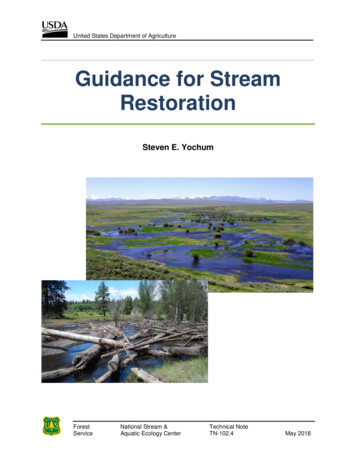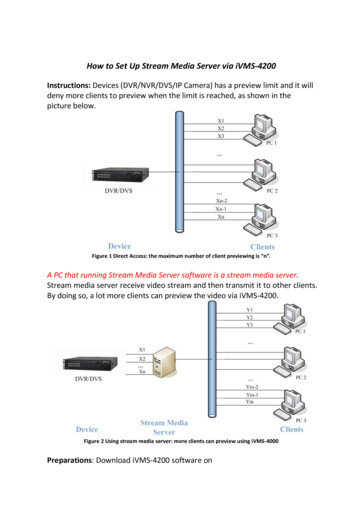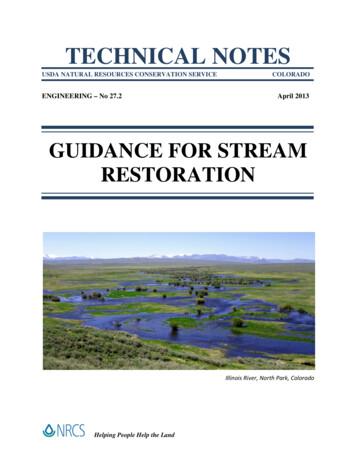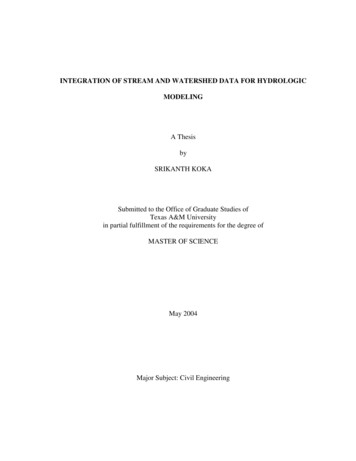
Transcription
United States Department of AgricultureGuidance for StreamRestorationSteven E. YochumForestServiceNational Stream &Aquatic Ecology CenterTechnical NoteTN-102.4May 2018
Yochum, Steven E. 2018. Guidance for Stream Restoration. U.S.Department of Agriculture, Forest Service, National Stream & AquaticEcology Center, Technical Note TN-102.4. Fort Collins, CO.Cover Photos:Top-right: Illinois River, North Park, Colorado.Photo by Steven YochumBottom-left: Whychus Creek, Oregon.Photo by Paul PowersABSTRACTA great deal of effort has been devoted to developing guidance for streamrestoration. The available resources are diverse, reflecting the wideranging approaches used and expertise required to develop effectivestream restoration projects. To help practitioners sort through theextensive information, this technical note has been developed to provide aguide to the available guidance. The document structure is primarily aseries of short literature reviews followed by a hyperlinked reference listfor readers to find more information on each topic. The primary topicsincorporated into this guidance include general methods, an overview ofstream processes and restoration, case studies, data compilation,preliminary assessments, and field data collection. Analysis methods andtools, and planning and design guidance for specific restoration featuresare also provided. This technical note is a bibliographic repository ofinformation available to assist professionals with the process of planning,analyzing, and designing stream restoration projects.U.S. Forest Service NSAECTN-102.4Guidance for Stream Restoration & Rehabilitation i of viFort Collins, ColoradoMay 2018
ADVISORY NOTETechniques and approaches contained in thistechnical note are not all-inclusive, noruniversally applicable. Designing streamrestorations and rehabilitations requiresappropriate training and experience, especially toidentify conditions where various approaches,tools, and techniques are most applicable, as wellas their limitations for design. Note also thatproduct names are included only to show type andavailability and do not constitute endorsement fortheir specific use.In accordance with Federal civil rights law andU.S. Department of Agriculture (USDA) civilrights regulations and policies, the USDA, itsAgencies, offices, and employees, and institutionsparticipating in or administering USDA programsare prohibited from discriminating based on race,color, national origin, religion, sex, genderidentity (including gender expression), sexualorientation, disability, age, marital status,family/parental status, income derived from apublic assistance program, political beliefs, orreprisal or retaliation for prior civil rightsactivity, in any program or activity conducted orfunded by USDA (not all bases apply to allprograms).Remedies and complaint filingdeadlines vary by program or incident.Persons with disabilities who require alternativemeans of communication for program information(e.g., Braille, large print, audiotape, AmericanSign Language, etc.) should contact theresponsible Agency or USDA’s TARGET Center at(202) 720-2600 (voice and TTY) or contact USDAthrough the Federal Relay Service at (800) 8778339.To file a program discrimination complaint,complete the USDA Program DiscriminationComplaint Form, AD-3027, found online athttp://www.ascr.usda.gov/complaint filing cust.html and at any USDA office or write a letteraddressed to USDA and provide in the letter all ofthe information requested in the form. To requesta copy of the complaint form, call (866) 632-9992.Submit your completed form or letter to USDA by:(1) mail: U.S. Department of Agriculture, Office ofthe Assistant Secretary for Civil Rights, 1400Independence Avenue, SW, Washington, D.C.20250-9410; (2) fax: (202) 690-7442; or (3)email: program.intake@usda.gov .USDA is an equal opportunity provider, employer,and lender.U.S. Forest Service NSAECTN-102.4Guidance for Stream Restoration & Rehabilitation ii of viFort Collins, ColoradoMay 2018
ACKNOWLEDGEMENTS3.2 Planning Process . 3This technical note was written by StevenYochum, PhD, PE, Hydrologist, U.S. ForestService, National Stream and Aquatic EcologyCenter. It is updated annually. The originaldocument was published by the USDA NaturalResources Conservation Service, Colorado StateOffice, with the initial version (ColoradoEngineering Tech Note 27.1) released in June2012.3.3 Watershed Approach . 44. RIPARIAN MANAGEMENT . 55. ADAPTIVE MANAGEMENT . 66. OVERVIEW of STREAM PROCESSES andRESTORATION . 77. CASE STUDIES . 98. DATA COMPILATION . 118.1 Data Sources. 11Peer review of version TN-102.1 of this USFSguidance was performed by Johan Hogervorst,USFS Hydrologist; Robert Tanner, USFSHydrologist; Paul Powers, USFS AquaticBiologist; Brady Dodd, USFS Hydrologist; andRobert Gubernick, USFS Geologist. Additionalreview of this latest version was completed byDavid Levinson.8.1.1 Water Quantity . 118.1.2 Water Quality and Sediment . 118.1.3 GIS Data and Mapping. 128.1.4 Climate Data. 128.1.5 Vegetative Information . 128.1.6 Literature . 138.2 Geographic Information System . 13Peer review of the original NRCS document wasperformed by Rob Sampson, NRCS StateConservation Engineer; Barry Southerland, NRCSFluvial Geomorphologist; Brian Bledsoe, CSUAssociate Professor of Civil and EnvironmentalEngineering; Terri Sage, NRCS Biologist; andChristine Taliga, NRCS Plant Materials Specialist.8.3 Historical Information . 139. PRELIMINARY FIELD ASSESSMENT . 149.1 Fundamental Principles . 169.1.1 Total and Unit Stream Power . 169.1.2 Shear Stress . 169.1.3 Momentum . 179.1.4 Roughness and Flow Resistance . 179.1.5 Lane’s Balance . 179.2 Stream Channel States and EvolutionModels . 18Other individuals have provided comments andclarifications to the document; all of theircontributions are highly appreciated. Please emailSteven Yochum with any additional comments orsuggestions, for inclusion in the next annualupdate.9.3 Stream Classification. 229.4 Stream Ecological Valuation (SEV). 239.5 Basic Assessment Tools . 23CONTENTS10. FIELD DATA COLLECTION . 2410.1 Aquatic Organisms . 24ABSTRACT. iADVISORY NOTE . iiACKNOWLEDGEMENTS . iiiCONTENTS. iiiFIGURES . ivTABLES . vi1. INTRODUCTION . 12. GOALS AND OBJECTIVES . 23. GENERAL METHODS. 33.1 Interdisciplinary Team . 3U.S. Forest Service NSAECTN-102.4Guidance for Stream Restoration & Rehabilitation iii of vi10.2 Riparian Vegetation. 2510.3 Topographic Survey Data. 2610.4 Bankfull Stage Identification. 2810.5 Discharge Measurements . 2910.6 Water Quality . 3010.7 Bed Material Sampling. 3110.8 Sediment Transport Measurements . 3210.9 Groundwater . 32Fort Collins, ColoradoMay 2018
12.8.3 Bendway Weirs . 7212.8.4 Spur Dikes . 7212.8.5 Bioengineering . 7312.8.6 Toe Wood . 7412.8.7 Log Jams . 7512.8.8 Rock Walls . 7612.8.9 Riprap . 7612.9 Bed Stabilization and Stream Diversions. 7711. DESIGN APPROACHES and ANALYSESfor STREAM RESTORATION . 3311.1 Extent of Analysis, Design, and Review3511.2 Hydrology for Stream Restoration andStability at Stream Crossings . 3611.2.1 Phase 1 . 3611.2.2 Phase 2 . 3611.3 Flow Frequency Estimates . 3711.4 Natural Channel Design . 3912.10 Planform Design . 8011.5 River Styles . 4112.11 Dam Removal . 8111.6 Soar and Thorne Restoration Design . 4211.7 Hydraulic Modeling Overview . 4311.8 Bankfull Characteristics . 4411.9 Modeling Tools . 4511.9.1 Hydraulic Analysis and AquaticHabitat. 4511.9.2 Bank/Bed Stability and Sediment . 4611.9.3 Environmental Flows . 4711.9.4 Watershed Modeling . 4711.10 Flow Resistance Estimation . 4811.10.1 General Guidance and Tools . 4911.10.2 Low-Gradient Channels . 4911.10.3 Mid-Gradient Channels. 5011.10.4 High-Gradient Channels . 5011.10.5 Floodplains. 5012. RESTORATION FEATURES. 5112.1 Vegetation . 5112.2 Livestock Grazing Management . 5412.3 Large Wood . 5612.3.1 Management for Large WoodRecruitment and Retention . 5712.3.2 Large Wood Structures . 5712.4 Stream Habitat and Environmental Flows. 6012.5 Longitudinal Connectivity . 6312.6 Fish Screening. 6612.7 Beavers. 6712.8 Bank Stabilization . 6912.8.1 Stream Barbs . 7012.8.2 Vanes . 7113. MONITORING and REPORTING . 8314. SUMMARY . 8315. REFERENCES . 84APPENDIX A: Table of Contents for NRCSStream Restoration Design, NEH Part 654 . 99APPENDIX B: Glossary of FluvialGeomorphology Terms . 100FIGURESFigure 1: The NRCS planning process. . 3Figure 2: Channel diagnostic procedure. 14Figure 3: Levels of stability assessments . 15Figure 4: Lane’s Balance. 18Figure 5: Channel evolution model, with channelcross sections illustrating the 5 channel stages. 19Figure 6: Various stream succession stages . 19Figure 7: Stream evolution model . 20Figure 8: Archetypal state-and-transition modelnetwork structures . 21Figure 9: Montgomery and Buffingtonclassification system. . 22Figure 10: Rosgen classification system. . 22Figure 17: Fish sampling . 24Figure 18: Macroinvertebrate samplingequipment . 24Figure 16: Vegetation zones within a ripariancross section . 25Figure 11: Differential surveying . 26Figure 12: Survey-grade GPS. . 26Figure 13: Diurnal temperature fluctuations. . 30U.S. Forest Service NSAECTN-102.4Guidance for Stream Restoration & Rehabilitation iv of viFort Collins, ColoradoMay 2018
Figure 14: Example bed material particle sizedistribution . 31Figure 15: Bedload trap. . 32Figure 19: Form- to processed-based restorationapproach spectrum for incised or artificiallyconfined streams. . 33Figure 20: Project screening matrix . 35Figure 21: Rapid geomorphic assessment riskcategories. . 36Figure 22: Flow frequency estimates for theCache la Poudre River, CO . 37Figure 23: Annual peak discharge trends, withrecord lengths from 85 - 127 years . 37Figure 24: Schematic illustrating the NaturalChannel Design method. . 40Figure 25: River Styles framework . 41Figure 26: Soar and Thorne stream restorationdesign procedure. . 42Figure 27: Analytical channel design using theCopeland method . 44Figure 28: Effective discharge computation . 45Figure 29: Milk Creek on the White RiverNational Forest . 48Figure 30: Flow resistance coefficient estimationtool. . 49Figure 31: Computation methodology for 𝝈𝝈𝝈𝝈 . 50Figure 32: Channel stability ratings for variousvegetative compositions . 52Figure 33: The use of a stinger for vegetativeplantings. . 52Figure 34: A grazing management planningprocess . 55Figure 35: Substantial wood loading in a highgradient stream channel. . 56Figure 36: Railroad tie drives in the RockyMountains resulted in instream wood removaland reduction in channel variability . 57Figure 37: Conceptual visualization of largewood recruitment, transport, and deposition . 57Figure 38: Windthrow emulation . 58Figure 39: Typical plan view illustratingwindthrow emulations orientations . 58Figure 40: Introduced large wood . 58Figure 41: Complex timber revetment. . 59Figure 42: Proposed restoration design strategyutilizing ecohydraulic principles and speciesfunctional traits. 60Figure 43: Meadow restoration of WhychusCreek, Oregon . 61Figure 44: Beaver dam in a previously-incisedstream channel. . 61Figure 45: Spectrum of road crossing impactsupon aquatic organism passage and floodresiliency . 63Figure 46: Culvert outlet drop, with Coho. . 64Figure 47: Pool and weir fishway. 64Figure 48: Fixed, inclined fish screen. . 66Figure 49: Beaver-dominated stream corridor . 67Figure 50: Beaver deceiver . 68Figure 51: Beaver baffler . 68Figure 52: Stream barb. . 70Figure 53: J-hook vane. . 71Figure 54: Log vanes at low flow providing bankstabilization and channel narrowing 2 years afterconstruction . 71Figure 55: Log J-hook vane providing bankstabilization and pool scour 4 years afterconstruction . 71Figure 56: Bendway weir . . 72Figure 57: Spur dike . 72Figure 58: Installation of coir fascines . 73Figure 59: Rootwad with footer section . 73Figure 60: Toe wood cross section . 74Figure 61: Two cells of a toe wood plan view. 74Figure 62: Log jam. . 75Figure 63: Vegetated rock wall . 76Figure 64: Cross vane on the Rio Blanco, CO . 77Figure 65: Large wood grade-control structure. 77Figure 66: Log “rock and roll” channel in theTrail Creek watershed, Colorado . 77Figure 67: Variable descriptions for U-vanestage-discharge rating. 78Figure 68: Bed stabilization in a wet meadowusing constructed riffles . 79Figure 69: Schematic illustrating variablesdescribing channel planform characteristics . 80Figure 70: Removal of the lower portion ofGlines Canyon Dam . 81TN-102.4U.S. Forest Service NSAECGuidance for Stream Restoration & Rehabilitation v of viFort Collins, ColoradoMay 2018
TABLESTable 1: Quick reference guide . 1Table 2: Riparian practices, with expectedriparian ecosystem benefits . 6Table 3: Role of primary field indicators fordiagnosing channel condition . 14Table 4: Possible field indicators of streaminstability and stability . 15Table 5: Descriptions of stream evolution model(SEM) stages, with comparison to the channelevolution model (CEM) stages presented inSchumm et al. (1984) . 21Table 6: Manning’s n in sand-bed channels. 49Table 7: Grazing system compatibility withwillow-dominated plant communities. 54Table 8: Evaluation and rating of grazingstrategies for stream-riparian-related fisheriesvalues . 55U.S. Forest Service NSAECTN-102.4Guidance for Stream Restoration & Rehabilitation vi of viFort Collins, ColoradoMay 2018
1. INTRODUCTIONNationally, large funding amounts are annuallyspent on stream restoration and rehabilitationprojects, with the results having variable successin satisfying project objectives. A likely lowestimate is that more than 1 billion is spent eachyear on such projects (Bernhardt et al. 2005). Tosupport this investment, over the last three decadesa great deal of effort has been devoted todeveloping technical guidance. These resourcesare diverse, which reflects the wide rangingapproaches used and expertise required in thepractice of stream restoration. Tens of thousandsof pages of relevant material are now available toassist practitioners with restoration projects. TheUSDA Natural Resources Conservation Service’s(NRCS) Stream Restoration Design manual(National Engineering Handbook, Part 654; NRCS2007) alone consists of more than 1600 pages!With such extensive information available, it canbe difficult for professionals to find the mostrelevant material available for specific projects.To help practitioners sort through all thisinformation, this technical note has beendeveloped to provide a guide to the guidance. It isa bibliographic repository of information availableto assist professionals with the process ofplanning, analyzing, and designing a streamrestoration or rehabilitation project. The documentstructure is primarily a series of short literaturereviews followed by a hyperlinked reference listfor the reader to find more information on eachtopic. Due to the extensive use of hyperlinks, thisdocument is best viewed as an on-screen pdf whileconnected to the web. Many potentially usefulreferences for stream projects are cited. However,the quantity of the available literature can beintimidating, even when only summarized.Prudent use of the table of contents can helpminimize the potential for being overwhelmed.Additionally, Table 1 provides a quick referenceguide for common technical needs.This document is not intended to be aphilosophical framework for restoration design;that effort is left to other references. Additionally,this guidance is not limited to only what areconsideredrestoration-focusedpractices;U.S. Forest Service NSAECGuidance for Stream Restorationrehabilitation features are also included, to providea more comprehensive resource. Restoration is thereestablishment of the structure and function ofecosystems to an approximation of predisturbance conditions while rehabilitationestablishes conditions to support natural processesfor making the land useful for human purposes(NRCS 2007). While both restoration andrehabilitation practices are presented in thisdocument, for simplicity they are lumped togetherunder the term restoration, as is common practice.Table 1: Quick reference guide.Technical NeedDefine goals and objectivesGeneral methods for developing alternativerestoration strategiesOverview of stream system processes andrestoration practicesLearn from past restoration projects, throughcase studiesResources for collecting existing backgrounddataWhat fundamental hydraulic principles governstream state and restoration practicesWhat are stream channel states and evolutionmodels?Methods for field data collection (surveying,discharge, water quality, sediment, vegetation,aquatic life)What design approaches and analyses areperformed for stream restoration?Page23791116182433How is bankfull stage determined?44How are flow-frequency estimates developed?37What is the Natural Channel Design method?39What is the River Styles method?41What hydraulic modeling tools can be utilized?45How is flow resistance estimated?48What practices are used in restoration?51How important is vegetation in restoration?51Livestock grazing management54Need for and installation of large wood56Stream habitat and environmental flows60Designing for fish passage63Fish Screening66What are the roles of beavers?67Structures for bank stabilization69Bed stabilization and stream diversions77Dam removal81Index to NRCS NEH Part 65499Glossary of restoration-related terms86TN-102.41 of 105Fort Collins, ColoradoMay 2018
Reduce rates of lateral migration of channelmeandering Narrow an overly-wide channel, decreasingthe width/depth ratio of the stream Improve water quality, such as excessivetemperature, nutrients, sediment, salts, andmetals Remove non-native riparian vegetation,replacing with more desirable species Reestablish a sinuous channel from achannelized reach Establish stream reaches capable oftransporting the available sediment supply Provide compliance with EndangeredSpecies Act and Clean Water ActrequirementsThis document is organized in the typical sequencefor assessing, analyzing, and designing streamrestoration projects. Appendices provide an indexfor the NRCS Stream Restoration Design manual(National Engineering Handbook, Part 654: NRCS2007), and a glossary of fluvial geomorphologyterms. Finally, the term stream restoration is usedfor all scales of streams, from small creeks to largerivers.2. GOALS AND OBJECTIVESOne of the most important steps in a streamrestoration project is the determination of projectgoals and objectives. Goals are general and arehighly dependent upon context, while objectivesare measurable and in support of the stated goals.Once established, goals need to be clarifiedthrough objectives that describe how the goals willbe attained. Objectives need to be specific,realistic, achievable and measurable (NRCS 2007,Ch. 2). The perceived success or failure of aproject is dependent upon thoughtful andconsensus-based development of goals andobjectives by the stakeholders and technicalspecialists. The social context of the restorationshould be accounted for – the successfulimplementation of restoration is dependent uponacceptance by those who live with the stream andits floodplain (Wohl et al. 2015).Project goals and objectives often considered instream corridor restoration and rehabilitationprojects include:During the planning and design processes, theattributes of the project must be assessed to assurethat the project objectives are being fully satisfied.Often, individual objectives are in conflict andneed to be prioritized to best meet the projectgoals. After construction, monitoring should beperformed to assess if the project is fulfilling thegoals and objectives. If not, project remediationmay be needed through adaptive management. Inany case, documentation of project performanceshould be maintained, for communication withstakeholders and adding to the knowledge base ofthe individual professional and the restorationcommunity as a whole.Additional information for establishing objectivesfor stream projects can be found in: Provide habitat enhancement for native orsport fishes, to increase abundance and ageclass diversity Prevent streambank erosion, to protectproperties and infrastructure Restore hydrologic function, includingdynamic channel processes Establish a multi-thread channel andcompanion riparian meadow, from anincised or channelized reach Slow the procession of headcutting in awatershed, to protect upland areas andinfrastructure, and to reduce sedimentdelivery to downstream reachesU.S. Forest Service NSAECGuidance for Stream RestorationTN-102.42 of 105 NRCS 2007 (Ch. 2) Goals, Objectives andRisk Fischenich 2006 Functional Objectives forStream RestorationFort Collins, ColoradoMay 2018
3. GENERAL METHODS3.2 Planning ProcessGeneral methods are provided for stream corridorimprovement projects. Topics covered include theassembly of an appropriate interdisciplinary team,the planning process, the watershed approach torestoration, an overview of riparian management,adaptive management, and the extent of designand review.Stream corridor restoration projects need a plan todevelop a logical sequence of steps to satisfy theproject objectives. The NRCS conservationplanning process (Figure 1) is one example of agenerally-accepted planning process. The methodconsists of nine steps that focus the planning teamon the overall system, to determine the cause of theproblem, formulate alternatives, and evaluate theeffects of each alternative on the overall streamsystem (NRCS 2007, Ch2). These steps are notnecessarily linear; the steps may need to be cycledthrough iteratively to develop the best set ofalternative solutions to a given problem, andultimately select and implement a certain set ofpractices. The nine steps are as follows:3.1 Interdisciplinary TeamStream corridor restoration projects are inherentlycomplicated. In most projects, no single individualhas all the required skills to effectively perform arestoration; an interdisciplinary team is required.Needed expertise varies by project and gy, soil science, restoration ecology,botany, and aquatic biology. However, the teamshould be no larger than required, to reduceinefficiencies resulting from an excessive numberof specialists being involved in a project.1. Identify problems and opportunities:What stream characteristics should bechanged? Is the noted condition actually aproblem?Figure 1: The NRCS planning process (NRCS 2007, Ch. 2).U.S. Forest Service NSAECGuidance for Stream RestorationTN-102.43 of 105Fort Collins, ColoradoMay 2018
2. Determine overall goals and specificobjectives: What are the desired physical,chemical and biological changes?3. Inventory resources: Study the stream tounderstand the dominant physical processes,impacts on water quality, and abundanceand distribution of biological populations.4. Analyze resource data: Evaluate thecollected information and decide whatprocesses most influence the desired streamcondition.5. Formulate alternatives: Determine whichprocesses can be changed. Include a noaction option.6. Evaluate alternatives: Which alternativesare sustainable, cost effective, and best meetstated goals and objectives?7. Make decisions: Develop a consensusbased decision by the stakeholders andinterdisciplinary team regarding whichalternative to implement.8. Implement the plan9. Evaluate the plan: Perform post projectmonitoring, to assess performance andrevise practices.3.3 Watershed ApproachWhile restoration is frequently initially consideredto address local concerns, a watershed approach isoften needed to address potential underlyingmechanisms causing the impairments. Anunderstanding of these mechanisms is necessary todevelop an effective response. Unless theunderlying causes of the degraded condition areaddressed, restoration may not be the wisestinvestment.Relevant questions to address include:Complimentary to this, standards for ecologicallysuccessful stream restoration projects have beendeveloped. It has been proposed (Palmer et al.2005) that five criteria essential for measuringproject success are:1. A dynamic ecological endpoint is initiallyidentified and used to guide the restoration.2. The ecological conditions of the stream aremeasurably improved.3. Through the use of natural fluvial andecological processes, the restored streammust be more self-sustaining and resilient toperturbationsthanpre-restorationconditions, so that minimal maintenance isneeded.4. The implementation of the restoration doesnot inflict lasting harm.5. Pre- and post-project assessments arecompleted and the data are made publicallyavailable so that the restoration communityas a whole can benefit from knowledgelearned.U.S. Forest Service NSAECGuidance for Stream RestorationTN-102.44 of 105 How has land use changed throughout thewatershed? What are the results of thesedisturbances? Impacts to consider include:o fireso invasi
Guidance for Stream Restoration & Rehabilitation i of vi May 2018 . Yochum, Steven E. 2018. Guidance for Stream Restoration. U.S. Department of Agriculture, Forest Service, National Stream & Aquatic Ecology Center, Technical Note TN -102.4. Fort Collins, CO. Cover Photos:










